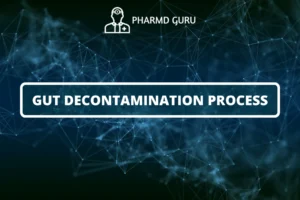Caustics are substances that can cause severe tissue damage and burns upon contact. Inorganic acids and alkali are common types of caustics.
SCROLL DOWN TO THE BOTTOM OF THE PAGE FOR ACTUAL NOTES
TABLE OF CONTENTS:
- Introduction
- Caustics: Inorganic Acids and Alkali
- Clinical Symptoms of Acute Caustic Poisoning
- Management of Acute Poisoning
- 4.1. Immediate Actions
- 4.2. Medical Interventions
- 4.3. Supportive Care
- Prevention Tips
1. Introduction
Caustics are substances that can cause severe tissue damage and burns upon contact. Inorganic acids and alkali are common types of caustics. Accidental ingestion or exposure to these substances can lead to acute poisoning, which requires prompt medical attention. This article explores the clinical symptoms associated with acute caustic poisoning and provides insights into the recommended management strategies.
2. Caustics: Inorganic Acids and Alkali
Inorganic acids, such as sulfuric acid and hydrochloric acid, and alkali, such as sodium hydroxide and potassium hydroxide, are corrosive substances commonly found in various industrial and household products.
3. Clinical Symptoms of Acute Caustic Poisoning
Acute caustic poisoning can manifest with the following clinical symptoms:
- Oral and Throat Burns: Ingestion of caustics can result in severe burns and damage to the oral cavity, throat, and esophagus. Symptoms may include mouth pain, difficulty swallowing, drooling, and hoarseness.
- Gastrointestinal Effects: Caustics can cause significant damage to the stomach and intestines, leading to abdominal pain, nausea, vomiting (which may contain blood), and bloody or black stools.
- Respiratory Distress: Inhalation of caustic fumes or aspiration of caustic substances can cause respiratory distress, including coughing, wheezing, chest pain, and shortness of breath.
- Systemic Symptoms: In severe cases, individuals may experience symptoms such as low blood pressure, rapid heart rate, dizziness, weakness, and signs of shock.
The severity of symptoms can vary depending on factors such as the type and concentration of the caustic substance and the duration of exposure.
4. Management of Acute Poisoning
4.1. Immediate Actions
In cases of acute caustic poisoning, it is essential to take the following immediate actions:
- Call Emergency Services: Contact local emergency services or a poison control center immediately to seek professional medical guidance.
- Provide Information: Provide detailed information about the type of caustic substance involved, the route of exposure, and the individual’s current symptoms.
4.2. Medical Interventions
Medical professionals may employ the following interventions for managing acute caustic poisoning:
- Airway Management: Ensuring a clear airway is a priority. If there are signs of respiratory distress, oxygen therapy or assisted ventilation may be necessary.
- Gastrointestinal Decontamination: Depending on the circumstances and timing, gastric lavage or activated charcoal administration may be considered to reduce further absorption of the caustic substance.
- Endoscopy: Endoscopic evaluation may be performed to assess the extent of injury to the esophagus, stomach, and upper gastrointestinal tract.
- Pain Management: Administering appropriate pain medications to help alleviate discomfort and manage pain associated with caustic burns.
- Monitoring and Observation: Continuous monitoring of vital signs, assessment of the extent of injury, and laboratory tests to evaluate organ function and the presence of complications.
4.3. Supportive Care
Supportive care is crucial in managing acute caustic poisoning and may involve:
- Fluid Resuscitation: Administering intravenous fluids to maintain hydration and support blood pressure in cases of significant fluid loss or shock.
- Nutritional Support: Providing enteral or parenteral nutrition to individuals who are unable to tolerate oral intake due to severe gastrointestinal damage.
- Psychological Support: Offering psychological support to individuals and their families due to the emotional and psychological impact of the poisoning incident.
5. Prevention Tips
Preventing caustic poisoning is essential. Consider the following tips:
- Proper Storage: Store caustic substances in clearly labeled, child-resistant containers and keep them out of reach of children.
- Safe Usage: Follow instructions and safety guidelines when using caustic products, such as wearing protective clothing and gloves.
- Education and Awareness: Educate individuals about the dangers of caustic substances and promote awareness of proper handling and storage practices.
ACTUAL NOTES




